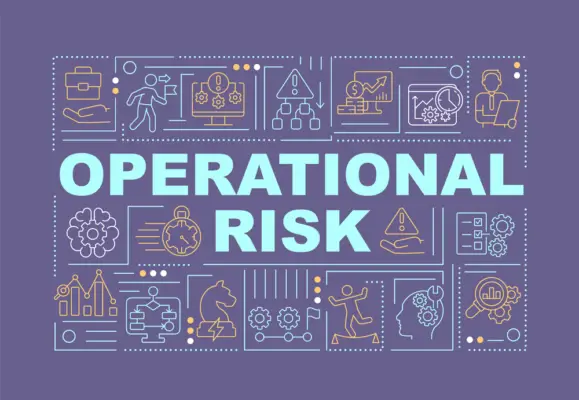In today’s increasingly complex business landscape, managing operational risk is of utmost importance for organizations to maintain their strategic business goals and daily business activities without business disruption. They include:-
- Align RCSA with business strategy (source). RCSA should assess risks that could impact business objectives.
- Establish a dynamic, iterative process (source). RCSA should be an ongoing process that is updated regularly as risks change over time.
- Enable an integrated approach. Risks and controls should be assessed holistically across the entire organization rather than as isolated silos.
- Quantify risk in monetary terms (source). Assigning dollar values to risks helps prioritize high-impact issues.
- Increase frontline participation (source). Staff with the most knowledge of day-to-day operations should be involved in RCSA.
- Define organizational hierarchy and risk taxonomy (source). Having a standardized framework makes RCSA consistent, comparable, and scalable across divisions.
This article explores the six best approaches to reducing RCSA (Risk Control Self-Assessment) operational risk, including using visualization tools and precise scoring methodologies for better real-time risk insights.
Organizations can mitigate potential risks by implementing robust RCSA frameworks, conducting regular self-assessments, and adopting a proactive risk management approach.
Additionally, engaging professional operational risk assessors can provide valuable expertise and insights.
Read on to discover the key strategies for effectively managing and reducing operational risk.

What is RCSA Operational Risk?
RCSA Operational Risk refers to the potential negative risk impact on an organization’s operations and processes, including material risks and future risks associated with today’s high-velocity, high-impact risks.
It encompasses various risks, such as financial, regulatory, and reputational risks.
Understanding and mitigating these risks is crucial for organizations as it can lead to improved efficiency, cost savings, and enhanced stakeholder confidence.
Benefits of Reducing Operational Risk
Reducing operational risk brings numerous benefits to an organization, including improved efficiency, enhanced reputation, and increased stakeholder confidence.
Operational risk refers to the potential for losses resulting from inadequate or failed internal processes, people, and systems or from external events.
An effective approach to reducing operational risk involves a systematic and proactive methodology known as the RCSA (Risk Control Self-Assessment).
This approach enables organizations to identify and assess operational risks by conducting a comprehensive analysis of their internal controls and processes.
1. Implementing Robust Internal Controls
Implementing robust internal controls is crucial for reducing operational risk in the RCSA process.
The first step is to identify and assess risks, which allows organizations to understand the potential areas of vulnerability.
Once risks are identified, the next step is establishing and maintaining internal controls that effectively mitigate those risks.
Lastly, documenting control self-assessment processes ensures transparency and accountability in implementing internal controls.
Identifying and Assessing Risks
One effective approach to enhance operational risk management involves the thorough identification and assessment of risks through the implementation of robust internal controls, considering the inherent risk environment and conducting qualitative risk assessments.
Identifying and assessing risks is a crucial practice for banks and other organizations to mitigate potential issues arising from their activities. The use of risk control self-assessment (RCSA) is a common practice in the banking industry for risk management.
By conducting a comprehensive risk evaluation, organizations can determine the inherent risk of their operations and develop appropriate control measures to reduce the level of risk exposure.
Risk assessors and operational risk professionals play a crucial role in this process by analyzing potential risks and their impact on the organization’s critical processes and operational efficiency.
This proactive approach enables organizations to develop action plans and establish strong relationships between business practices and the effectiveness of controls to minimize potential threats and potential losses.
Establishing and Maintaining Internal Controls
To ensure effective risk management, organizations must establish and maintain robust internal controls that align with their identified risks and operational objectives.
Implementing strong internal controls is essential for mitigating operational risk losses and minimizing potential impacts on the business.
Here are five key elements to consider when establishing and maintaining internal controls:
- Regular reviews: Conduct periodic reviews of internal control procedures to ensure their effectiveness and identify any areas of improvement.
- Utilize tools: Implement appropriate tools and technology to automate and streamline internal processes, ensuring efficiency and accuracy.
- Control self-assessment: Encourage employees to participate in control self-assessment activities, promoting a culture of accountability and risk awareness.
- Assessment of controls: Continuously assess the effectiveness of key controls to identify any gaps or weaknesses and take necessary corrective actions.
- Integration with risk framework: Integrate internal controls with the organization’s risk framework and enterprise risk management strategy to ensure a comprehensive approach to risk mitigation.
Documenting Control Self-Assessment Processes
The documentation of control self-assessment processes is a crucial step in establishing and maintaining robust internal controls.
By documenting these processes, organizations can effectively manage and mitigate operational risks. This documentation ensures that control activities are properly designed and implemented and helps identify any gaps or weaknesses in the control environment.
To highlight the importance of documenting control self-assessment processes, the following table provides an overview of key components that should be included:
| Component | Description |
|---|---|
| Context | Understand the external events and internal factors that impact the organization’s risk profile. |
| Control Environment | Establish the tone at the top and ensure the right control culture is in place. |
| Operational Risk Management Program | Implement a structured approach to identify, assess, and manage operational risks. |
| Risk Assessments | Conduct qualitative and quantitative risk assessments to prioritize and measure risks. |
2. Conducting Regular Risk Control Self-Assessments (RCSAs)
To effectively conduct regular Risk Control Self-Assessments (RCSAs), organizations must focus on three key points.
First, they need to identify both inherent and residual risks within their operations to understand the potential areas of vulnerability.
Second, evaluating the effectiveness of existing internal controls is crucial to ensure they adequately mitigate these risks.
Finally, organizations must prioritize compliance with corporate policies and procedures to minimize operational risk and maintain regulatory requirements.

Identifying Inherent and Residual Risks
One essential step in reducing operational risk through RCSAs is identifying inherent and residual risks. This process involves a comprehensive risk assessment to identify potential risks impacting the organization’s operations.
Effective risk management strategies can be developed by understanding inherent risks and taking mitigation actions.
Here are five key points to consider when identifying inherent and residual risks:
- Adopt a control approach that integrates risk management into everyday operations.
- Conduct a continuous review of risks to ensure they are up-to-date and relevant.
- Engage all business units in the risk assessment process to gain a comprehensive understanding of the organization’s risk profile.
- Identify causal relationships between different risks to address interconnected vulnerabilities.
- Move away from a periodic tick-the-box exercise and focus on a proactive and dynamic approach to risk identification and management.
Evaluating the Effectiveness of Existing Internal Controls
Effective evaluation of existing internal controls is crucial in reducing RCSA operational risk. Evaluating the effectiveness of internal controls allows organizations to identify and address any weaknesses or blind spots that may exist.
Key risks, including business and operational risks, should be considered during this evaluation process.
One approach to evaluating internal controls is conducting regular Risk Control Self-Assessments (RCSAs). RCSAs involve the sharing of information and insights across different departments and levels of the organization, enabling a comprehensive assessment of control effectiveness.
Additionally, scenario analysis, project reviews, business continuity management tests, and audits can also be used to evaluate the effectiveness of internal controls.
The goal of these evaluations is to ensure that controls are robust, reliable, and capable of mitigating risks effectively.
Ensuring Compliance with Corporate Policies and Procedures
Regular Risk Control Self-Assessments (RCSAs) are a vital tool for ensuring compliance with corporate policies and procedures. To effectively conduct RCSAs and ensure compliance, organizations should consider the following:
- Exercise a standardized approach: Implementing a standardized approach to RCSAs ensures consistency and comparability across different business units or departments.
- Involve the operational risk division: The operational risk division is crucial in coordinating and overseeing RCSAs, providing expertise and guidance to risk professionals.
- Gain visibility into risks: RCSAs provide organizations with valuable insights into their risk landscape, enabling them to identify and address potential compliance gaps or weaknesses.
- Conduct trend analysis: By analyzing trends and patterns identified through RCSAs, organizations can proactively identify emerging risks and adjust their compliance strategies accordingly.
- Align with corporate policies and procedures: RCSAs should be designed to assess and validate adherence to corporate policies and procedures, ensuring ongoing compliance.
3. Adopting a Proactive Risk Management Approach
To adopt a proactive risk management approach, organizations must anticipate external events impacting their operations and develop strategies to mitigate potential risks. This requires staying informed about industry trends, regulatory changes, and emerging risks.
Additionally, establishing effective monitoring systems to track key risks is crucial for early detection and timely mitigation.
Organizations can minimize operational risks by proactively protecting themselves..
Anticipating External Events that May Impact Operations
By adopting a proactive risk management approach, organizations can effectively anticipate external events that may impact their operations.
This is crucial in today’s rapidly changing business landscape, where technology risks, distributions, and high-velocity risks are becoming increasingly common.
To ensure preparedness, organizations should consider the following:
- Implementing robust business continuity management and project management practices to identify and mitigate potential disruptions.
- Regularly monitoring and evaluating the external environment to identify emerging risks and trends.
- Establishing clear event requirements and building blocks to enhance the organization’s ability to respond to unforeseen events.
- Implementing preventive controls to minimize the likelihood of risks materializing.
- Involving senior management in the risk management process to ensure buy-in and support.
Developing Strategies to Mitigate Potential Risks
Organizations can effectively mitigate potential risks by adopting a proactive risk management approach. Developing strategies to mitigate potential risks is essential for reducing operational risk and ensuring the success of the RCSA (Risk Control Self-Assessment) process.
There are six best approaches to reduce RCSA operational risk, including risk assessment, risk appetite, risk posture, risk prevention, and risk quantification.
Organizations can identify and assess risks, establish risk posture, and take necessary measures to minimize risks. Risk quantification helps in understanding the potential impact and likelihood of risks.
Frequently Asked Questions
What Are the Key Benefits of Implementing RCSA Operational Risk?
Implementing RCSA operational risk can provide several key benefits. It enables organizations to identify and assess potential risks, improve control processes, enhance decision-making, increase operational efficiency, reduce loss events, and strengthen overall risk management practices.
How Can Organizations Ensure the Effectiveness of Their Internal Controls?
Organizations can ensure the effectiveness of their internal controls by conducting regular assessments, implementing robust monitoring mechanisms, fostering a strong risk culture, providing continuous training to employees, and leveraging technology to automate control processes.
What Are the Common Challenges Faced During the Implementation of RCSA Operational Risk?
Common challenges faced during the implementation of RCSA operational risk include inadequate resources, lack of stakeholder buy-in, poor data quality, and difficulty integrating the risk assessment process with existing systems and processes.
How Can Organizations Ensure Risk Control Self-Assessments Are Conducted in a Consistent and Unbiased Manner?
Organizations can ensure consistent and unbiased risk control self-assessments by establishing clear guidelines and procedures, providing comprehensive training to assessors, implementing a robust review process, and promoting a culture of open communication and accountability.
What Are Some Best Practices for Engaging Professional Operational Risk Assessors?
Engaging professional operational risk assessors requires clear communication, defined roles and responsibilities, and a thorough understanding of the organization’s risk management framework.
Regular training and development opportunities should also be provided to enhance assessors’ skills and knowledge.

Conclusion
Implementing robust internal controls is one approach to reducing RCSA operational risk. Regular risk control self-assessments (RCSAs) can help identify and address potential risks.
Additionally, adopting a proactive risk management approach is crucial in minimizing operational risks. Engaging professional operational risk assessors can provide valuable expertise in risk mitigation.
These strategies collectively reduce RCSA operational risk by helping organizations identify and address potential risks, promoting a culture of risk awareness, and ensuring effective risk mitigation. By implementing these measures, organizations can enhance their overall performance and increase their resilience.

Chris Ekai is a Risk Management expert with over 10 years of experience in the field. He has a Master’s(MSc) degree in Risk Management from University of Portsmouth and is a CPA and Finance professional. He currently works as a Content Manager at Risk Publishing, writing about Enterprise Risk Management, Business Continuity Management and Project Management.

